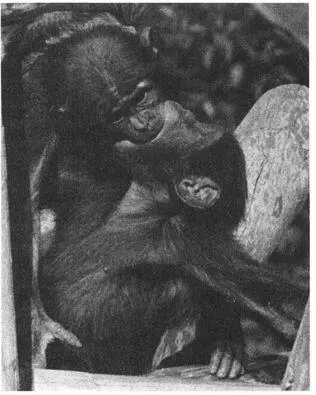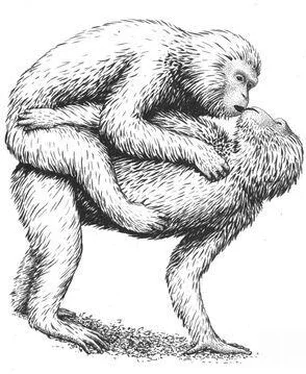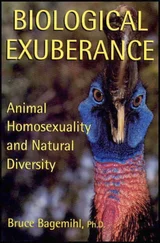Bruce Bagemihlv - Biological Exuberance - Animal Homosexuality and Natural Diversity
Здесь есть возможность читать онлайн «Bruce Bagemihlv - Biological Exuberance - Animal Homosexuality and Natural Diversity» весь текст электронной книги совершенно бесплатно (целиком полную версию без сокращений). В некоторых случаях можно слушать аудио, скачать через торрент в формате fb2 и присутствует краткое содержание. Жанр: Природа и животные, на английском языке. Описание произведения, (предисловие) а так же отзывы посетителей доступны на портале библиотеки ЛибКат.
- Название:Biological Exuberance: Animal Homosexuality and Natural Diversity
- Автор:
- Жанр:
- Год:неизвестен
- ISBN:нет данных
- Рейтинг книги:4 / 5. Голосов: 1
-
Избранное:Добавить в избранное
- Отзывы:
-
Ваша оценка:
- 80
- 1
- 2
- 3
- 4
- 5
Biological Exuberance: Animal Homosexuality and Natural Diversity: краткое содержание, описание и аннотация
Предлагаем к чтению аннотацию, описание, краткое содержание или предисловие (зависит от того, что написал сам автор книги «Biological Exuberance: Animal Homosexuality and Natural Diversity»). Если вы не нашли необходимую информацию о книге — напишите в комментариях, мы постараемся отыскать её.
Biological Exuberance: Animal Homosexuality and Natural Diversity — читать онлайн бесплатно полную книгу (весь текст) целиком
Ниже представлен текст книги, разбитый по страницам. Система сохранения места последней прочитанной страницы, позволяет с удобством читать онлайн бесплатно книгу «Biological Exuberance: Animal Homosexuality and Natural Diversity», без необходимости каждый раз заново искать на чём Вы остановились. Поставьте закладку, и сможете в любой момент перейти на страницу, на которой закончили чтение.
Интервал:
Закладка:
Numerous species of Monkeys and Apes also “hug” or embrace same-sex partners in homosexual contexts (usually face-to-face, although male Bonobos and Vervets also embrace while standing in a front-to-back position). Among non-primates, female Bottlenose Dolphins clasp each other during homosexual activity, male West Indian Manatees embrace one another underwater, while Gray-headed Flying Foxes wrap their wing-membranes around same-sex partners while stimulating each other. A striking form of same-sex embracing is the “sleeping huddle” found in Stumptail and Bonnet Macaques: a pair of males often sleep together in a front-to-back position, one male wrapping his arms around the other and sometimes even holding on to his partner’s penis. A similar sleeping arrangement occurs, surprisingly, among male Walruses, who often sleep in same-sex pairs or extended “chains” of males, all clasping each other in a front-to-back position as they float at the water’s surface.
Two younger male Bonobos kissing

(PHOTO BY FRANS DE WAAL)
A number of mammals also engage in mock battles or “play-fights” that have erotic overtones. Although they superficially resemble aggressive behavior, these “battles” or “contests” do not involve any physical violence and are clearly distinguished from actual cases of aggressive or territorial behavior in these species. Male African Elephants, for example, frequently become sexually aroused and develop erections when they perform ritualized erotic jousting matches, while numerous hoofed mammals such as male Giraffes, Bison, Blackbuck antelopes, and Mule Deer mount each other during play-fights or ritualistic jousting. Among primates such as Orang-utans, Gibbons, and Proboscis Monkeys, males sometimes engage in playful wrestling matches that can develop into sexual encounters, while male Australian and New Zealand Sea Lions also indulge in play-fighting combined with same-sex mounting. Although play-fighting is most common among male mammals, female Cheetahs sometimes engage in “mock fighting” with each other as part of same-sex courtship sequences, while female (and male) Galahs and Orange-fronted Parakeets in same-sex pairs have playful “fencing bouts” with their bills. 7
Many other types of affectionate and contactual behaviors occur between animals of the same sex. Sometimes animals gently bite, nibble, or chew on each other’s ears (female Hoary Marmots), or wings and chests (Gray-headed Flying Foxes), or rumps (male Dwarf Cavies), or necks (male Savanna Baboons). Male African Elephants intertwine their trunks, while female Japanese Macaques sometimes suck each other’s nipples, and male Crested Black Macaques and Savanna Baboons affectionately pat or grab other males’ rear ends. Pairs of animals may sit, huddle, or lie together in close proximity, sometimes touching hands or putting an arm around the shoulder (female Gorillas, Squirrel Monkeys, and Japanese Macaques, male Siamangs), while male Hanuman Langurs “cuddle” together by sitting back-to-front, one male between the other’s legs with his partner’s hands resting on his loins. Male Lions and female Long-eared Hedgehogs slide the lengths of their bodies along their partner’s, while male Bowhead Whales, Killer Whales, and Gray Seals roll their bodies over each other, and same-sex companions in Gray Whales and Botos swim side by side while gently touching each other with their fins.
Some animals have developed unique forms of touching that combine several different types of affectionate activities along with courtship and sexual behaviors. Male Giraffes engage in “necking”, a multifaceted activity that incorporates elements of play-fighting, courtship, and sexuality, in which they rub their necks along each other’s body while also licking, sniffing, and becoming sexually aroused by one another. In Giraffes and other species, these types of activities sometimes involve multiple animals interacting simultaneously in near “orgies” of bodily contact. Spinner Dolphins, for example, participate in “wuzzles”—group sessions of mutual caressing and sexual activity (both same-sex and opposite-sex)—while West Indian Manatees have a similar sort of “free-for-all” group activity known as cavorting, which can involve rubbing, chasing, and sexual interactions, among many other activities. Among birds, Hammerheads, Acorn Woodpeckers, and Blue-bellied Rollers have ritualized bouts of courtship and mounting activity that may involve groups of individuals and both same-sex and opposite-sex partners. The distinctive and, in many cases, unabashedly sensual and playful aspects of some of these activities are aptly reflected in the descriptive names given to them by zoologists. In fact, the term wuzzle —though used as a technical designation for this behavior in the scientific literature—is actually a nonsense word coined by a marine biologist, whose whimsical “etymology” for the name could be right out of Lewis Carroll: “The term comes from W. E. Schevill of Woods Hole Oceanographic Institution, who, when asked what the behavior was, replied without hesitation, ‘Why, it looks like a wuzzle to me.’” 8
Mounting, Diddling, and Bump-Rumping: Sexual Techniques
Affectionate activity often leads to, or is inseparable from, overtly sexual behavior—defined here as any contact between two or more animals involving genital stimulation. Stumptail and Crab-eating Macaques, for example, kiss their same-sex partners during sexual mounting. In fact, mounting is the most common type of sexual behavior found in homosexual contexts: one animal climbs on top of the other in a position similar to heterosexual intercourse, usually from behind in a front-to-back position (that is, one animal mounted on the back of the other). More than 95 percent of mammal and bird species use this position, for both male and female homosexual interactions. On the other hand, some animals—particularly primates such as Gorillas, Bonobos, and White-handed Gibbons—use a face-to-face position (in addition to, or instead of), and in some cases this is more common in homosexual encounters than in heterosexual ones. Belly-to-belly copulation is also the norm for both homosexual and heterosexual interactions in Dolphins. Occasionally more unusual or “creative” mounting positions are used, particularly by female animals. In Bonobos, Stumptail Macaques, and Japanese Macaques, for instance, females sometimes interact in a supine or semirecumbent position, one individual behind the other with her partner between her legs or sitting “in her lap” (which may also be done in a face-to-face position). Occasionally female Warthogs, Rhesus and Japanese Macaques, Koalas, and Takhi mount their female partner from the side rather than from behind; lateral mounts also sometimes occur during heterosexual interactions in these (and other) species. And in some animals a “backward,” head-to-tail mounting position is occasionally used, e.g., in Botos, Hammerheads, Ruffs, and Western Gulls. Most same-sex interactions involve only two individuals at a time, but group sexual (and courtship) activity—involving anywhere from three or four (Giraffes, Lions) to six or more (Bowhead Whales, Mountain Sheep) partners—occurs in over 25 different species.
The actual type of genital contact varies widely. Full penetration in male anal intercourse occurs in some species (for example, Orang-utans, Rhesus Macaques, Bison, and Bighorn rams), while female penetration of various types occurs during lesbian interactions in Orang-utans (insertion of the finger into the vagina), Bonobos (insertion of the erect clitoris into the vulva), and Bottlenose and Spinner Dolphins (insertion of a fin or tail fluke into the female’s genital slit). Simple pelvic thrusting and rubbing of the genitals on the rump of the other animal is widespread in both male and female homosexual mounts (occurring in the Northern Fur Seal, Lion, and Proboscis Monkey, among others), and simple genital-to-genital touching is the form of homosexual (and heterosexual) contact in species where males do not have a penis (as in most birds, such as the Pukeko and Tree Swallow). A more unusual type of male homosexual contact involves various forms of non -anal penetration. In Whales and Dolphins, both males and females have a genital slit or opening; when not aroused, the male’s penis is contained in the cavity leading to this slit. Homosexual activity in Bowhead Whales, Bottlenose Dolphins, and Botos sometimes involves insertion of the penis of one male into the genital slit of the other. Other more unusual forms of penetration have also been documented: male Botos occasionally insert the penis into a male partner’s blowhole (on the top of his head!), while male Orang-utans have even been observed retracting their penis to form a sort of “hollow” or concavity that another male can penetrate. Clitoral rubbing or other types of genital tribadism are found in female Bonobos, Gorillas, and Rhesus Macaques (among others), while males in several species (e.g., White-handed Gibbons, West Indian Manatees, and Gray Whales) rub their penises together or on each other’s body. In male Bonobos, mutual genital rubbing sometimes takes the form of an activity with the colorful name of “penis fencing,” in which the males hang suspended by their arms and rub their erect organs against each other.
Читать дальшеИнтервал:
Закладка:
Похожие книги на «Biological Exuberance: Animal Homosexuality and Natural Diversity»
Представляем Вашему вниманию похожие книги на «Biological Exuberance: Animal Homosexuality and Natural Diversity» списком для выбора. Мы отобрали схожую по названию и смыслу литературу в надежде предоставить читателям больше вариантов отыскать новые, интересные, ещё непрочитанные произведения.
Обсуждение, отзывы о книге «Biological Exuberance: Animal Homosexuality and Natural Diversity» и просто собственные мнения читателей. Оставьте ваши комментарии, напишите, что Вы думаете о произведении, его смысле или главных героях. Укажите что конкретно понравилось, а что нет, и почему Вы так считаете.








![Various - Birds and Nature, Vol. 10 No. 1 [June 1901]](/books/745231/various-birds-and-nature-vol-10-no-1-june-1901-thumb.webp)
![Various - Birds and Nature Vol. 10 No. 5 [December 1901]](/books/745236/various-birds-and-nature-vol-10-no-5-december-1-thumb.webp)

![Various - Birds and Nature, Vol. 12 No. 5 [December 1902]](/books/745517/various-birds-and-nature-vol-12-no-5-december-thumb.webp)
![Various - Birds and Nature Vol. 11 No. 2 [February 1902]](/books/745533/various-birds-and-nature-vol-11-no-2-february-1-thumb.webp)